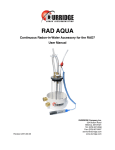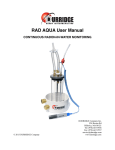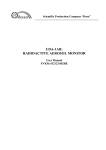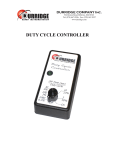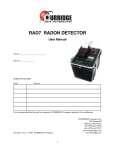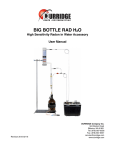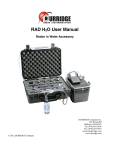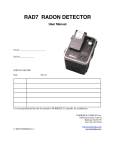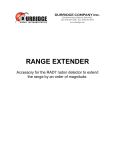Download RAD7 Natural Rock Sample
Transcript
Natural Rock Sample Manual DURRIDGE Company Inc. 524 Boston Road Billerica, MA 01821 Tel: (978) 667-9556 Fax: (978) 667-9557 [email protected] www.durridge.com Revision 2014-06-12 © 2014, DURRIDGE Company Inc. Table of Contents Introduction! Fig. 1 Natural Rock Sample Components 3 3 1 RAD7 Radon Sensitivity Check! Fig. 2 Radon Sensitivity Check config. 4 4 1.1 Purge the RAD7! 4 1.2 Hook up to the Natural Rock Sample! 4 1.3 Start a 3-Hour Test! 5 1.4 Radon Data Assessment! 5 1.5 Multiple RAD7s! 6 1.6 Cumulative Spectrum! 7 2 RAD7 Thoron Sensitivity Check! 8 2.1 Thoron Measurement! Fig. 3 Thoron Measurement Standard Setup 8 8 2.1.1 Radon Interference! 2.2 Rough Thoron Check! 9 9 2.3 Better Thoron Check! Fig. 4 Thoron Sensitivity Check configuration 2.2.1 Experimental Protocol! 2.2.2 Calculation! 2.2.3 Assessing The Thoron Data! 3 CAPTURE! 2 © 2014, DURRIDGE Company Inc. 9 10 11 11 11 12 Introduction Introduction The Natural Rock Sample is exactly that, a 21oz (600g) sample of granite gravel from a stone quarry, normally sold by the truckload as construction material. It is enclosed in a container that may be completely sealed using a pair of ball valves,. Granite generally contains trace amounts of both uranium and thorium that has been in the rock since it was formed, millions if not billions of years ago. Therefore all the progeny of both the uranium and thorium decay chains are fully supported and in full equilibrium down to 226Ra and 224-Ra. The rock sample is dry and therefore constitutes a rock-steady emitter of both radon and thoron. This manual shows how to take advantage of that property to check the performance of a RAD7. Please note that, to keep the emission constant, it is essential that the rock sample always be kept fully dry. Always use a drying tube, with blue, active desiccant in it, in the closed loop radon calibration circuit, or upstream of the desiccant in the thoron calibration configuration, in order to keep the rock sample permanently bone dry. If the desiccant in the small tube gets used up it should be replaced or regenerated. For thoron sensitivity measurement, the carrier air, pushing the thoron into the sample path, should be dried before it enters the rock sample. The Natural Rock Sample device can provide a means for monitoring long-term changes in both radon and thoron sensitivity. After calibration at DURRIDGE Company, and with the optional Thoron Calibration Check Kit, the Natural Rock Sample can be used for low-precision checking of both the radon and thoron sensitivities of any RAD7. Fig. 1 Natural Rock Sample Components © 2014, DURRIDGE Company Inc. 3 1 RAD7 Radon Sensitivity Check 1 RAD7 Radon Sensitivity Check After a month sitting sealed on a shelf, the radon in the rock sample container will have reached within 1% of a steady value where the rate of emission of radon into the container is equal to the rate of loss by decay and leakage, if any. If that quantity of radon is known, and if it is distributed around an air loop of known volume, then the radon concentration in the air in that loop is known. If one of the devices in the air loop is a RAD7, its measurement of the radon concentration in the air may be compared with the known concentration, and thus the sensitivity of the RAD7 effectively checked. If a correction is made to the rock sample radon reading for radon added to the air loop by the ambient air, after purging the RAD7, (see section 1.4), the fresh-air measurement should be kept going until two or three cycles are completed. In practice, provided the setup is identical to the calibration setup, all that is required to check the RAD7 sensitivity is to compare the ‘standardized’ average RAD7 reading (see below) with the standardized average reading on the rock sample calibration certificate. The ratio of the two will give a correction factor that may be applied directly to RAD7 readings. 1.1 Purge the RAD7 Purge the RAD7 with dry air in an open loop for at least 5 minutes, then switch to 1-day protocol: select Setup → Protocol → 1-day and push [ENTER]. Start a reading, still sampling fresh air through a drying unit. Go to the third status window (push the [Menu] key, then push[ENTER], [ENTER] → Rt Arrow → Rt Arrow, and observe the relative humidity in the top right corner. Keep the reading going until the RH is below 9%, then switch off the RAD7. If a correction is to be made to the rock sample radon reading for radon added to the air loop by the ambient air, after purging the RAD7, (see paragraph 1.4), the fresh-air measurement should be kept going until at least one and preferably two or three cycles are completed. 1.2 Hook up to the Natural Rock Sample Hook the RAD7 up to the Natural Rock Sample using only the tubing and small drying tube as provided with the rock sample. Use the exact configuration shown in the diagram below. Fig. 2 Radon Sensitivity Check config. © 2014, DURRIDGE Company Inc. 4 1 RAD7 Radon Sensitivity Check 1.3 Start a 3-Hour Test 1.4 Radon Data Assessment Switch on the RAD7 and press the menu key. Select 1-day protocol (Setup → Protocol → 1day, [ENTER]). Change the Recycle count to 6 ( Setup → Protocol → Recycle → 06, [ENTER]). Switch off the RAD7. If the rock sample was never calibrated, keep the average of the last four readings (3, 4, 5, and 6) in a record for future reference. Every standard RAD7 should produce nearly the same result with that rock sample if its sensitivity is as calibrated and if the rock sample is dry and has been sealed for at least a month. For greater reproducibility, 2/3 of the ambient air radon concentration can be subtracted from the averaged readings to correct for the residual radon in the air in the system after purging. However, if the ambient radon concentration in the air is less than 100 Bq/m3 (2.7 pCi/L) the error introduced by ignoring it will be less than 1%. Switch on the RAD7 printer. Switch on the RAD7 and let it print out the header, including a review of the settings. Check the printed review to make sure the Cycle time is 00:30 (30 minutes) and the Recycle is 06. Open the ball valves on the rock sample container and start a test (Test → Start, [ENTER]). Keep the measurement going until all six cycles are complete and the summary is printed out (3 hours). Average the last four readings. Record that average with the date. If no thoron test is to be conducted (see below) switch off the RAD7 and printer and close the ball valves on the rock sample container. Mark the rock sample container with the date. Remove the tubing, replace the caps on the small drying tube and store them with the rock sample for another month or more, before the next sensitivity check. If a thoron check is to be conducted, the best time to do it would be immediately after the radon check. When all experiments with the rock sample are completed, close the ball valves and stick a label on the container showing the date on which the valves were closed. If they are opened, for any reason, on a later date, remove the old label and replace it with a new label showing the last date on which the valves were closed, and left closed. The rock sample will be ready for another radon check not before one month from that date. If the rock sample has been calibrated by DURRIDGE Company, the calibration certificate gives the standardized average of readings 3, 4, 5 and 6, obtained with the standard setup, a well purged and dry RAD7 and 30minute cycles. Thus the ratio of the value stated on the rock sample calibration certificate to the measured standardized average gives you the correction factor directly. RAD7 readings multiplied by that ratio will give readings consistent with the DURRIDGE calibration system to within, say, 8%. Thus the rock sample, therefore, enables a calibration check once a month, referred back to the EPA National Standard and NIST, to within 8%. You may also, if you wish, calculate the total radon amount in the air loop, and hence originally in the rock sample container. If the radon amount is Rn and the volume of the air loop is V then the radon concentration is Rn/V. The air volume in the rock sample is 459ml, a standard RAD7 is 937ml and the tubing with small drying tube is 16ml, for a total volume of a standard rock sample system with standard RAD7 of 1.412 L. If Rn is expressed in pCi, then the radon concentration will be Rn/1.412 © 2014, DURRIDGE Company Inc. 5 1 RAD7 Radon Sensitivity Check pCi/L. If Rn is expressed in Bq, then the radon concentration will be Rn/1.412 Bq/L, or 1000 * Rn / 1.412 Bq/m3. In pCi, Rn = 1.412 * radon concentration in pCi/ L. In Bq, Rn = 0.001412 * radon concentration in Bq/m3 If the certified and observed standardized average values differ by more than, say, 8%, we recommend that the RAD7 be returned to DURRIDGE Company for service. If, after several monthly sensitivity checks, there is a consistent ratio between the observed and the certified standardized average radon concentration, you may consider applying a multiplier to all readings made with that RAD7, to bring them in line with the rock sample standard. If you notice a big jump, up or down, in the reading, from the previous month, first look to see if the RAD7 was properly purged before the measurement was started. If there is no obvious reason for the jump, the RAD7 should be returned to DURRIDGE for service. 1.5 Multiple RAD7s Before using the Natural Rock Sample to check a RAD7’s radon sensitivity, the rock sample must be left sealed for a month, in order for the radon inside the container to reach equilibrium. That means a RAD7 can have its sensitivity checked on a regular basis each month. However, there is nothing to stop us hooking up multiple RAD7s in series in the loop connected to the rock sample. This increases the volume of the loop and hence decreases the radon concentration in the loop, but by a predictable and reproducible amount. This method is recommended for checking up to six RAD7s on a monthly basis. 6 © 2014, DURRIDGE Company Inc. For the sake of argument, using rounded figures, let us assume that the total quantity of radon inside the rock sample container, when in equilibrium, is equal to 2 Bq. Let us also assume that the rock sample and tubing has an air volume of 500ml while a RAD7 is 1L. Then when the RAD7 is connected up to the rock sample and the radon distributed around the loop, the radon concentration will be 2 / 1.5 = 1.333 Bq/L = 1333 Bq/m3. If every additional RAD7 adds 1L to the loop, then four RAD7s would total 4.5L, including the rock sample and tubing. The radon concentration in the loop would then become 2 / 4.5 = 0.444 Bq/L = 444 Bq/m3. While this is less than 1333 Bq/m3 it is still sufficiently high to make a good reading in a couple of hours and a relatively high precision measurement in 12 hours. Each month, all four RAD7s can be connected in series with one another and thoroughly purged and dried out, before being connected to the rock sample to obtain a sensitivity check. Each month the setup should be identical, with the same number of RAD7s and the same pieces of tubing to connect up the entire loop. During the measurement all the RAD7 pumps, except one, should be set to OFF ( Setup → Pump → Off, [ENTER].) If any of the RAD7s had developed a leak, the radon concentration in the loop would fall rapidly. Thus in addition to keeping a record of the average readings during the check, for each month, a record of the slope of the average for all RAD7s should also be maintained, as the radon concentration falls off over time from decay and any leakage. If during one month the slope is steeper than usual, that would be an indication of a leak in the loop somewhere. Although it is possible to combine several RAD7s in a loop for monthly radon sensitivity checks, this technique will not work for checking thoron sensitivity, due to the loss of 1 RAD7 Radon Sensitivity Check thoron in the air as it travels around the loop. However, there is no need to wait between successive thoron checks and all the RAD7s can undergo the rough thoron check individually, sequentially, without any delay between measuring the thoron response of one RAD7 and the next. The monthly protocol may therefore be: 1. Connect all RAD7s in series, set all protocols to 1-day, set all pumps, except one, to OFF. Put a laboratory drying unit upstream of the line, with one end open to fresh air. 2. Set the RAD7 with an active pump to Purge, for 15 minutes, to purge all residual radon out of the RAD7s and start to dry them out. 3. Select Test → Start, [ENTER] on all RAD7s, starting a 1-day test in each of them (with only one pump operating). 4. After at least two cycles (1 hour), or preferably 3 cycles (1.5 hours), stop the tests. 5. Disconnect the large drying unit. Connect the string of RAD7s to the rock sample and small drying tube. 6. Open the valves and select Test → Start, [ENTER] on all RAD7s (all still in 1-day protocol and with all pumps, except one, set to OFF). 7. Depending on the precision required, after between 3 and 24 hours, the tests may be stopped and the RAD7s disconnected. 8. If required, rough thoron checks may then be performed with each RAD7, separately connected to the rock sample. 9. Careful notes should be kept of all actions and readings, and all data downloaded from each RAD7 to a PC with CAPTURE. 10. Finally, the tubing should be disconnected from the rock sample and the valves closed for another month. 1.6 Cumulative Spectrum It is important that the cumulative spectrum (based on counts from multiple cycles) be printed and inspected periodically. It gives excellent diagnostic information on the health of the instrument. Using the Natural Rock Sample to check the calibration of the RAD7 every month is a convenient opportunity to inspect the cumulative spectrum. With the Recycle set to 6 cycles, as indicated above, at the end of the sixth cycle the RAD7 will automatically finish the run and print out a run summary. This consists of some data, a bar chart of the six readings and then the cumulative spectrum. That spectrum should show a sharp peak in the A window, about midway between the boundaries. There may also be peaks in the other three windows and at 5.3 MeV (210-Po) just to the left of the A window. Please see the RAD7 manual for a description and image of some possible pathological spectra. © 2014, DURRIDGE Company Inc. 7 2 RAD7 Thoron Sensitivity Check 2 RAD7 Thoron Sensitivity Check 2.1 Thoron Measurement The RAD7 is capable of making a direct measurement of thoron gas concentration in air. It does this by counting 216Po decays inside its measurement chamber. Thoron however has a short half life, 55.6s, so most of the thoron in the sample will be lost during acquisition if the time from sampling to entering the measurement chamber exceeds even a minute. Therefore when measuring thoron the sample acquisition time must be as short as conveniently possible, and always consistent. Additionally, the exact same setup should be used for thoron calibration as for thoron measurement. This setup necessarily involves a specific length of tubing and a small tube of desiccant, as the RAD7 detector is less sensitive in a humid environment. The setup assumed in the RAD7 data processing and stated as standard in the manual consists of a small drying tube, which may be used as a wand for sniffing, along with a standard input tubing of 36” (91.4cm) length and inner diameter of 3/16” (4.8mm), as shown below. This typically gives the RAD7 a thoron sensitivity of about half its radon Sniff sensitivity. The 216Po daughter of thoron has only a 145mS half life so the main component in the response time of the RAD7 to a step change in thoron concentration is the time taken to acquire the sample. The response is virtually instantaneous. Fig. 3 Thoron Measurement Standard Setup © 2014, DURRIDGE Company Inc. 8 2 RAD7 Thoron Sensitivity Check 2.1.1 Radon Interference The alpha particle from 216Po decay has an energy of 6.78 MeV, which is between the 218Po and 214Po peaks in the 222Rn decay chain. That places it within the B window of the RAD7 spectrum, while the 214Po peak lies in the C window. About 1% of the 214Po counts are in a low energy tail from the peak, and spill into window B. The spill factor is measured during calibration and the count in window B is corrected for that spill by the RAD7 and by CAPTURE when calculating the thoron concentration. Nevertheless, the presence of a large spill from window C would increase the uncertainty of the thoron count in window B. It is therefore important that the C window count be low when performing a thoron measurement or calibration. If a radon calibration check of a RAD7 has been performed with a Rock Sample, it would be good to wait an hour or two for the count rate in window C to drop below 10 cpm, before proceeding with the thoron calibration check. 2.2 Rough Thoron Check Before closing the ball valves and disassembling the setup, change the protocol to Thoron by selecting Setup → Protocol → Thoron, [ENTER]. Then turn the RAD7 off and back on, and let the printer print out the new header for thoron. Start a measurement. Let it run for at least 15 minutes (3 five-minute cycles), or more if you would like a higher precision average. Average all the thoron readings. Store the thoron average reading with the radon average. This thoron reading cannot be used to check the thoron sensitivity of the RAD7 as the reading is heavily dependent on the pump flow rate and even the position of items in the setup. If the desiccant is placed upstream instead of down stream of the rock sample it will make no difference to the radon average reading, but will make a big difference to the thoron readings. Even just switching the connections to the rock sample can affect the thoron readings. However, if the setup remains identical in every respect from one monthly check to the next, if the RAD7 pump is still working at close to the same flow rate, and if the inlet filter is not blocked, then thoron readings made with this setup will be similar from one month to the next. After several months of experience the user will know the typical variation and will recognize an anomalous shift, should it occur. 2.3 Better Thoron Check A more accurate thoron sensitivity check involves the Thoron Calibration Check Kit, which is sold separately. To check the thoron sensitivity of a RAD7 using this kit, the measurement must be made in precisely the same conditions and using the same configuration as thoron measurements in regular use. In standard thoron protocol, the RAD7 has 1m of 3/16” ID tubing between the inlet filter and a small drying tube, which may be used as a wand for sniffing purposes. The thoron check process therefore requires that the sampling point at the end of the small drying tube must be open to the air. It is the thoron concentration at that sampling point that we measure. Thus we put a T-connector at that location, inject thoron at a known rate, using a carrier with less than the RAD7 flow rate, and with fresh air from the other side of the Tconnector supplying the balance of air to make up the RAD7 flow rate. This configuration is illustrated on the following page. © 2014, DURRIDGE Company Inc. 9 2 RAD7 Thoron Sensitivity Check Fig. 4 Thoron Sensitivity Check configuration 10 © 2014, DURRIDGE Company Inc. 2 RAD7 Thoron Sensitivity Check 2.2.1 Experimental Protocol a) Set up the experiment exactly as in the diagram above, or else with the RAD7 sampling path in exactly the same setup as will be used for measuring thoron. b) Adjust the flow rate through the rock sample to 0.55 L/min. A flow rate of 0.55 L/min is chosen as a standard flow rate for injecting thoron into the RAD7 sample path because that may be relied upon to be less than the RAD7 pump flow rate, that may range from 0.6 L/min to 1 L/min or higher. With the set up as shown in the diagram above, run the external pump and adjust the needle valve so that the air flowing through the rock sample is 0.55 L/min. c) Move the flow meter to the RAD7 outlet. Remove the flow meter from its position between the needle valve and the rock sample and reconnect the tubing so that the needle valve is connected directly to the rock sample. Connect RAD7 outlet to the input of the flow meter. The external pump can be kept running during this maneuver. d) Change the RAD7 to thoron protocol. Use the default thoron protocol (Setup → Protocol → Thoron, [ENTER]), or choose the default and then change individual parameters (e.g. cycle time) as desired. Turn off the RAD7, turn on the printer, turn on the RAD7 and let it print out a header. Examine the header to make sure everything is OK. e) Start a reading: Test → Start, [ENTER]. 2.2.2 Calculation With an identical rock sample air flow rate (0.55 L/min) and identical tubing attached to the T connector, for every thoron calibration check, the rate of injection of thoron into the sample flow will always be the same. Let this be Th. The units of Th are pCi per minute or Bq per minute. If the RAD7 flow rate, measured at the RAD7 outlet, is V L/min, then the thoron concentration in the sample air flow at the sampling point (which is very close to the T connection) will be Th/V. If Th is expressed in pCi/min and V is in L/min then Th/V will be pCi/L. If Th is expressed in Bq/min and the flow is in L/min then Th/V will be Bq/L. To convert to Bq/m3 multiply by 1000. 2.2.3 Assessing The Thoron Data For an uncalibrated rock sample, note the average thoron reading and the RAD7 flow rate. Multiply the thoron reading by the flow rate to get Th, the rate of injection of thoron into the sample flow (for units of Bq/m3 and L/min, divide the product by 1,000 to get Bq/min). The experiment may be repeated as often as desired. There is no need to wait for any ingrowth. However, after conducting this experiment, the rock sample must be left sealed for a month before a radon check may be performed. The obvious time to do this experiment is immediately after a radon check. As an option, DURRIDGE Company will calibrate a rock sample for thoron. With a setup as above and a flow rate of 0.55 L/min through the rock sample, we give you the rate of injection of thoron into the RAD7 sample path. You may then divide that by the flow rate of the target RAD7 to obtain the thoron concentration at the sampling point. This may be compared with the thoron reading in the RAD7 and a correction factor derived. Records of the radon and thoron readings should be kept safely for later reference and comparison. © 2014, DURRIDGE Company Inc. 11 3 CAPTURE 3 CAPTURE Durridge’s CAPTURE software establishes profiles for each RAD7 it detects, with each profile representing a set of calibration parameters. If the RAD7 data contains good thoron and radon readings, with radon readings in NORMAL as well as SNIFF mode, and if the data is downloaded with the “include supplementary data” box checked, CAPTURE will have all the information it needs to determine the internally stored radon and thoron sensitivities, which it then reveals in the RAD7 statistics box shown to the right of the graph. If you know the correction factors you need to apply to radon and thoron readings, you can calculate the corrected sensitivities. (If the correction factor by which a reading must be multiplied is, say, 1.05, then the stored sensitivity should be divided by 1.05 to get the corrected sensitivity.) Thus you can calculate the corrected sensitivities for NORMAL, SNIFF and THORON readings, to be entered into a new RAD7 Profile and stored by CAPTURE. The new profile should be assigned to any RAD7 data sets produced after the date that has been assigned to the profile. More information on configuring RAD7 Profiles is available in the CAPTURE User’s Manual. The manual is included with the software, and it may also be downloaded from the DURRIDGE website. © 2014, DURRIDGE Company Inc. 12













